ASUS Z97-Pro WiFi AC Review
by Ian Cutress on July 16, 2014 10:00 AM EST- Posted in
- Motherboards
- Asus
- Haswell
- 802.11ac
- Z97
CPU Benchmarks
Readers of our motherboard review section will have noted the trend in modern motherboards to implement a form of MultiCore Enhancement / Acceleration / Turbo (read our report here) on their motherboards. This does several things – better benchmark results at stock settings (not entirely needed if overclocking is an end-user goal), at the expense of heat and temperature, but also gives in essence an automatic overclock which may be against what the user wants. Our testing methodology is ‘out-of-the-box’, with the latest public BIOS installed and XMP enabled, and thus subject to the whims of this feature. It is ultimately up to the motherboard manufacturer to take this risk – and manufacturers taking risks in the setup is something they do on every product (think C-state settings, USB priority, DPC Latency / monitoring priority, memory subtimings at JEDEC). Processor speed change is part of that risk which is clearly visible, and ultimately if no overclocking is planned, some motherboards will affect how fast that shiny new processor goes and can be an important factor in the purchase.
Compression – WinRAR 5.0.1: link
Our WinRAR test from 2013 is updated to the latest version of WinRAR at the start of 2014. We compress a set of 2867 files across 320 folders totaling 1.52 GB in size – 95% of these files are small typical website files, and the rest (90% of the size) are small 30 second 720p videos.

Image Manipulation – FastStone Image Viewer 4.9: link
Similarly to WinRAR, the FastStone test us updated for 2014 to the latest version. FastStone is the program I use to perform quick or bulk actions on images, such as resizing, adjusting for color and cropping. In our test we take a series of 170 images in various sizes and formats and convert them all into 640x480 .gif files, maintaining the aspect ratio. FastStone does not use multithreading for this test, and thus single threaded performance is often the winner.
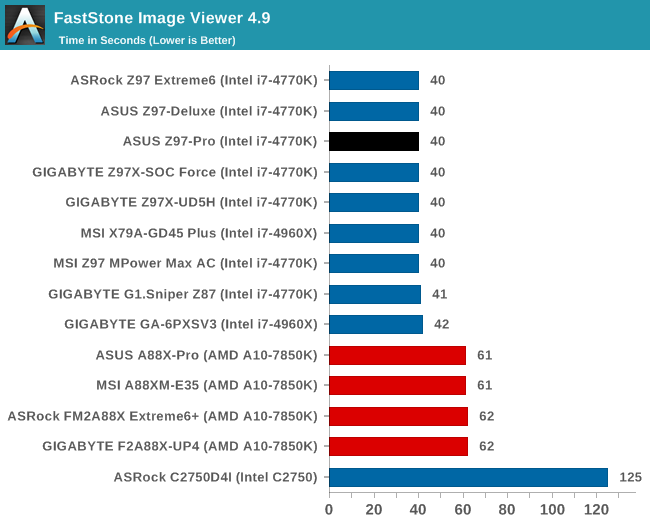
Video Conversion – Xilisoft Video Converter 7: link
The XVC test I normally do is updated to the full version of the software, and this time a different test as well. Here we take two different videos: a double UHD (3840x4320) clip of 10 minutes and a 640x266 DVD rip of a 2h20 film and convert both to iPod suitable formats. The reasoning here is simple – when frames are small enough to fit into memory, the algorithm has more chance to apply work between threads and process the video quicker. Results shown are in seconds and time taken to encode.
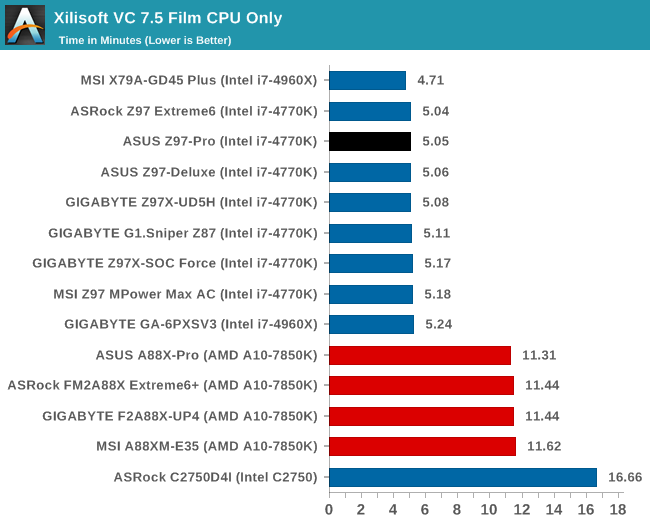

Video Conversion – Handbrake v0.9.9: link
Handbrake is a media conversion tool that was initially designed to help DVD ISOs and Video CDs into more common video formats. The principle today is still the same, primarily as an output for H.264 + AAC/MP3 audio within an MKV container. In our test we use the same videos as in the Xilisoft test, and results are given in frames per second.

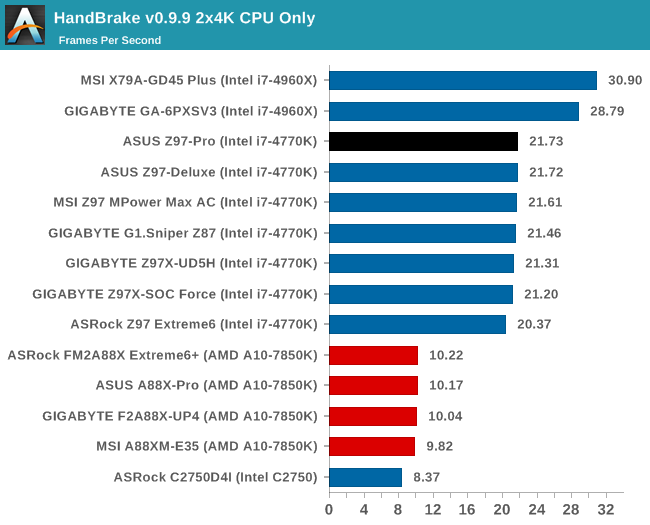
Rendering – PovRay 3.7: link
The Persistence of Vision RayTracer, or PovRay, is a freeware package for as the name suggests, ray tracing. It is a pure renderer, rather than modeling software, but the latest beta version contains a handy benchmark for stressing all processing threads on a platform. We have been using this test in motherboard reviews to test memory stability at various CPU speeds to good effect – if it passes the test, the IMC in the CPU is stable for a given CPU speed. As a CPU test, it runs for approximately 2-3 minutes on high end platforms.
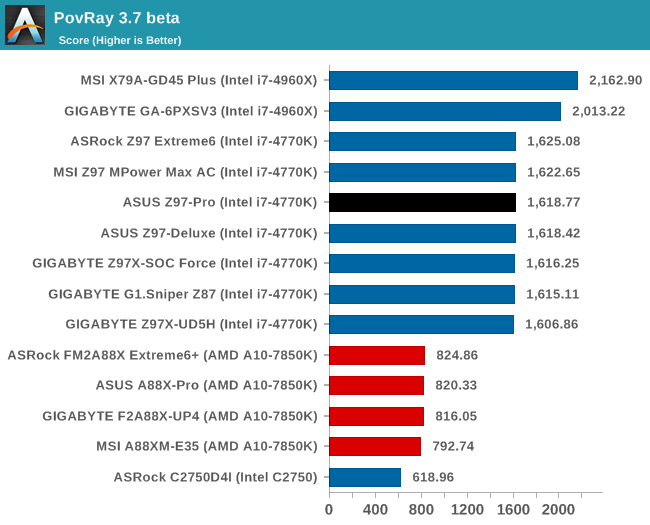
2D to 3D Rendering –Agisoft PhotoScan v1.0: link
Agisoft Photoscan creates 3D models from 2D images, a process which is very computationally expensive. The algorithm is split into four distinct phases, and different phases of the model reconstruction require either fast memory, fast IPC, more cores, or even OpenCL compute devices to hand. Agisoft supplied us with a special version of the software to script the process, where we take 50 images of a stately home and convert it into a medium quality model. This benchmark typically takes around 15-20 minutes on a high end PC on the CPU alone, with GPUs reducing the time.
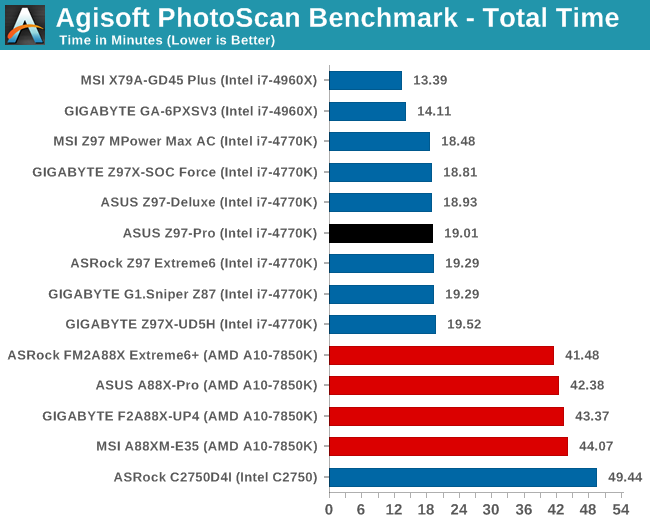
Console Emulation –Dolphin Benchmark: link
At the start of 2014 I was emailed with a link to a new emulation benchmark based on the Dolphin Emulator. The issue with emulators tends to be two-fold: game licensing and raw CPU power required for the emulation. As a result, many emulators are often bound by single thread CPU performance, and general reports tended to suggest that Haswell provided a significant boost to emulator performance. This benchmark runs a Wii program that raytraces a complex 3D scene inside the Dolphin Wii emulator. Performance on this benchmark is a good proxy of the speed of Dolphin CPU emulation, which is an intensive single core task using most aspects of a CPU. Results are given in minutes, where the Wii itself scores 17.53; meaning that anything above this is faster than an actual Wii for processing Wii code, albeit emulated.
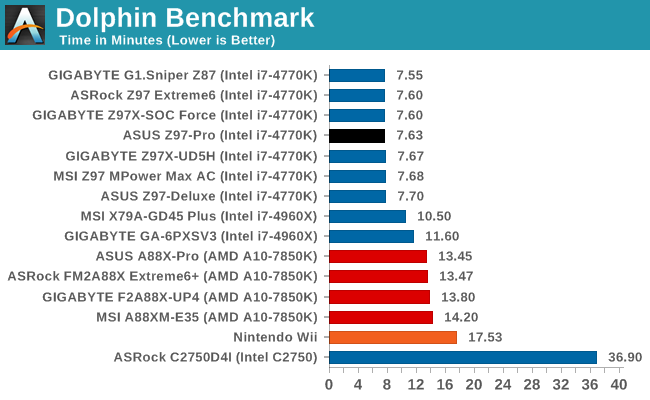
Point Calculations – 3D Movement Algorithm Test: link
3DPM is a self-penned benchmark, taking basic 3D movement algorithms used in Brownian Motion simulations and testing them for speed. High floating point performance, MHz and IPC wins in the single thread version, whereas the multithread version has to handle the threads and loves more cores.
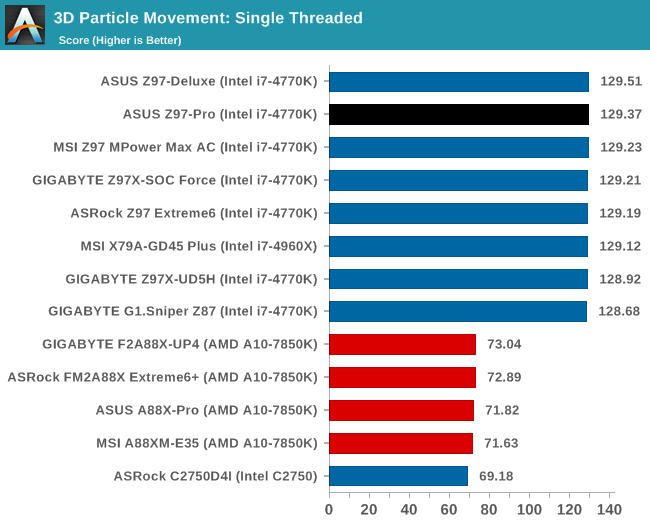
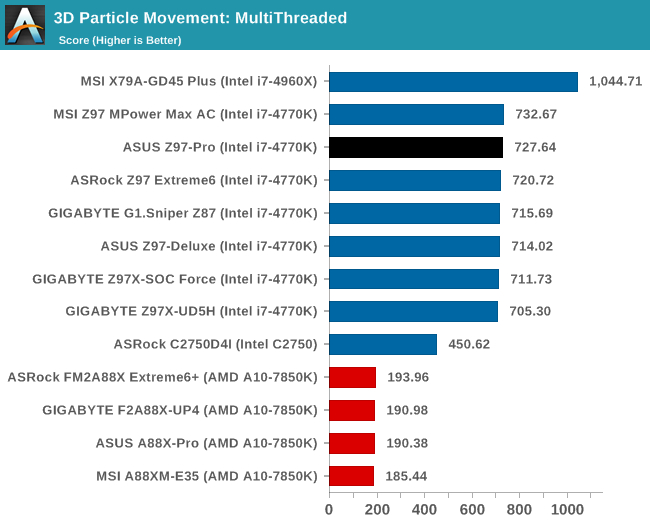
Synthetic – 7-Zip 9.2: link
As an open source compression tool, 7-Zip is a popular tool for making sets of files easier to handle and transfer. The software offers up its own benchmark, to which we report the result.
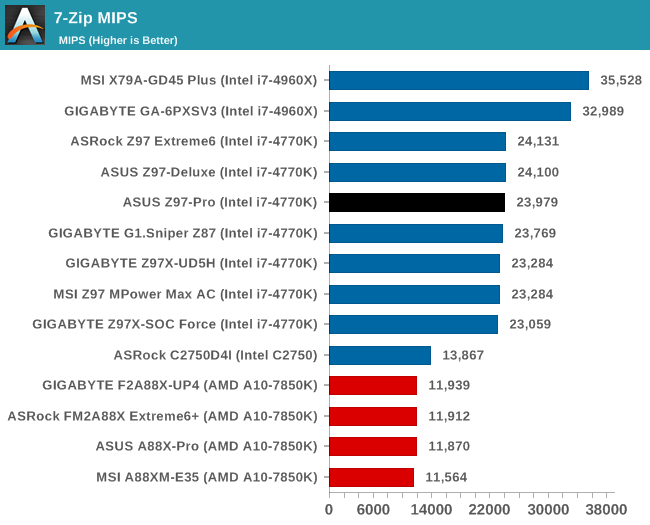










38 Comments
View All Comments
DanNeely - Wednesday, July 16, 2014 - link
Where're you finding it for <$200? Newegg has it at $219. The shopping search in the where to buy link picks up several lower spec models in the same family.owan - Wednesday, July 16, 2014 - link
Reading all these z97 reviews only underscores how badly intel needs to increase the number of available PCIe lanes, particularly the 3.0 lanes off the CPUGigaplex - Wednesday, July 16, 2014 - link
That's why Intel has the enthusiast socket 2011 platform.DanNeely - Friday, July 18, 2014 - link
Unfortunately Intel's kept it crippled by delaying the enthusiast CPUs using it until they complete all the extra testing/validation they claim is needed for Xeons but not regular consumer parts. If they'd release the enthusiast parts at about the same time as the mass market ones and then the Xeon's a year later it'd get much more respect. As it stands, it's basically just smoke and mirrors.rchris - Wednesday, July 16, 2014 - link
Appreciate the fine review. However, I really wish product reviews would include some data or sampling of the manufacturer's customer service performance. I know there are feedback comments on sites such as Newegg.com, but they are all horror stories and it's hard to tell if they represent what typically happens when you get a lemon and have to deal with it.ggathagan - Wednesday, July 16, 2014 - link
What would be better would be an investigative article that dealt solely with the quality of customer service from all the manufacturers over a period of, say 2-3 months.There are only a handful of motherboard providers. To add this to every review would be needlessly redundant.
Customer service tends to be quite hit-or-miss, since so much of it depends on the individual who takes your call.
Farwalker2u - Wednesday, July 16, 2014 - link
Hysteresis, the dependence of the output of a system not only on its current input, but also on its history of past inputs.I had to look it up.
I never knew there was such a system. Your suggestion for additional fan settings with this as part of the mix makes sense.
demonqueller - Friday, July 18, 2014 - link
No Firewire ports on this board either. Since they were lacking on Asrock's and MSI's offerings, does this mean Firewire is dead? Those of us with external Firewire audio interfaces have to rely once again on third-party add-on cards. Not a huge deal, but the extra cost (and crowding on the board) is annoying.DanNeely - Friday, July 18, 2014 - link
Yeah, it's more or less dead. At this point it's not even so much the $5-10 that adding the controller/port increases the retail cost. It's that the controller eats a PCIe lane and Intel doesn't give us enough of them; virtually every mid/high end ATX motherboard is either having lane allocation switched around in software or using a PLX as a port multiplier to add more lanes. FW lingered as long as it did because as long as you had a PCI controller (either in the chipset or a PCIe-PCI bridge chip) you could hang several devices off it for the cost of routing traces to them.The rumor is that Intel will be increasing CPU PCIe lanes on Skylake from 16 to 20; but with that ostentatiously being about PCIe based storage; they really need to offer an enthusiast chipset with 12 or 16 lanes instead of 8 too.
demonqueller - Friday, July 18, 2014 - link
Yes, more lanes would be nice. ... I'm building a new rig using the 4790K chip to replace my ancient CoreDuo 8400. I haven't settled on a board yet; I'm wavering between this ASUS or ASrock's Extreme 6. The computer primarily will be used for music recording / mixing, but I also do 3D work. Anyway, my old rig, with a max of 8GB RAM struggled. I hope that won't be an issue anymore with 32GB, even if I'm using a PCI card to support my Firewire ports.